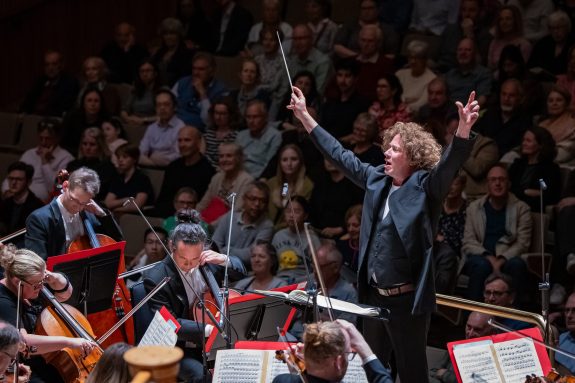 United Kingdom Liszt, Shostakovich and Elgar: Sol Gabetta (cello), Philharmonia / Santtu-Matias Rouvali (conductor). Royal Festival Hall, London, 6.6.2024. (AK)
United Kingdom Liszt, Shostakovich and Elgar: Sol Gabetta (cello), Philharmonia / Santtu-Matias Rouvali (conductor). Royal Festival Hall, London, 6.6.2024. (AK)

Liszt (arr. Doppler) – Hungarian Rhapsody No.2
Shostakovich – Cello Concerto No.1
Elgar – Enigma Variations
The Philharmonia advertised this concert as ‘Santtu conducts Elgar’s Enigma Variations’, even the tickets for entrance were printed with this specification. Presumably the orchestra has a very good relationship with its principal conductor Santtu-Matias Rouvali, hence referring to him by his first name. However, I wonder if this marketing confuses the hierarchy of artistic ingredients that is the role of the composer and conductor. Interestingly, this was Rouvali’s first ever performance of the Enigma Variations but we would not have guessed it from the marketing description or, I hasten to add, from the excellent performance.
First up was the Liszt Rhapsody. It originates from one of Liszt’s sixteen piano pieces called Hungarian Rhapsodies. Liszt heard the basic tunes incorporated in the series in Hungary, but they are not Hungarian. These tunes were known in Hungary, they were performed by gypsy and army bands, but they were not original Hungarian tunes, even if Liszt thought so. Interestingly, he dedicated most of these rhapsodies – consisting of two parts, slow and fast – to various Hungarian noblemen: No.2 to Count László Teleki. The orchestral version performed at this concert was made by famous flute player Albert Doppler, with Liszt’s approval.

Rouvali (or should I refer to him as Santtu?) presented what he evidently believed was an authentic approach and was greatly aided by his Hungarian-born concert master Zsolt-Tihamér Visontay. The latter led with such vigorous body movements which might have surprised Hungarian Gypsy musicians playing similar tunes. Clarinettist Mark van de Wiel presented admirable virtuoso embellished solo passages (in my view, possibly a touch too fast) in the slow part of the rhapsody. In the fast section, Rouvali sped up and slowed down more than indicated in my original piano score but the performance was effective and the audience loved it.
Shostakovich’s Cello Concerto is a beast. Even as an ex-cellist – or perhaps because of it – I cannot imagine how cellists manage to play it. It is full of technical difficulties, such as high position notes, double stops, long sections of harmonic notes, fast passages. Furthermore, the cello part is relentless for full half an hour. Soloist Sol Gabetta looked at ease with what seemed to me a rather large cello (or perhaps she is just delicately slim) and performed this marathon as if it was all in a day’s work. Gabetta sings on her cello beautifully (with a few more slides between notes than what I would prefer), her communication with the orchestra is exemplary. Gabetta’s energy level is mind-blowing: the third movement, a cadenza for solo cello, could have tripped her but it did not. Last but not least, Gabetta is a musician without gimmicks, she does not try to portray for all and sundry that she is a great artist (which she is).
The orchestra for this concerto consists of strings, wind, timpani and celeste, with the single horn fulfilling a crucial part duetting with the solo cello. At times one feels this is a double concerto for solo cello and solo horn. Horn player Ben Hulme was rock solid with his highly musical rendering and – I hasten to add – with not a single note cracked (although cracked notes come with the territory for horn playing).
Gabetta gave us a beautiful encore, but without anybody announcing what it was. Well, as my post-performance research revealed it, it was the second movement (Nana) from De Falla’s Suite populaire espagnole, this time arranged for solo cello and celeste. De Falla’s original version is for voice and piano (as Siete canciones populares españolas) but arrangements for violin-piano by Paweł Kochański and cello-piano by Maurice Maréchal followed.
Elgar’s Enigma Variations gave the whole orchestra the opportunity (with full brass and wind after the slimmed down Shostakovich orchestration) to show their competence and commitment. This was the first time that Rouvali conducted the piece though I am sure that this was not the first time for the orchestra. They seemed at ease with all sections of the score in all sections of the orchestra. Clarinet player Mark van de Wiel delighted again with his lovely conclusion to variation I and then his mastery in variation XIII, the whole orchestra presented beautiful cantilena in variation V, the timpani (Mark McDonald) showed that even in fast sections it is possibly to follow dynamics as specified by the composer (variation VII). ‘Nimrod’ (variation IX) was utterly beautiful as was Rouvali’s slight pause on concluding this movement.
Elgar scored his Enigma Variations for full orchestra and added an organ ad lib. We did have the organ in this performance, and it did raise the excitement in the triumphant finish when it joined the orchestra in the final variation (XIV). We left the auditorium on cloud nine.
The concert was recorded live for BBC Radio 3 and can be heard on BBC Sounds until 6th July (that is thirty days after the concert).
Agnes Kory
